- How to Find the Best Drum Pedals - December 8, 2021
- Best Marching Snare Drum Guide: With My Top 4 Recommendations - December 3, 2021
- Best Overhead Drum Mic Options - December 1, 2021
Choosing drum sticks that match your playing style is a process that is sometimes disregarded, as most musicians rightly focus on finding a drum set and cymbal arrangement that allows them to fully express their musical identity. Finding the appropriate set of sticks, on the other hand, is no easy task.
Playing with a well-balanced set of sticks that feel good will undoubtedly increase your playing comfort and bring forth the greatest tones from your kit and cymbals.
There is no handbook for selecting drumsticks, whether you are a beginner or a seasoned player. I’ve been playing for nearly 20 years, yet even I have trouble finding the right pair for the job.
While I’m sure it would be a wonderful endeavor, testing just every stick on the market would take forever. To save you time, here’s a brief cheat sheet to help you feel confident the next time you walk into a music store.
Traditional Stick Numbering
The standard method of numbering drum sticks, which uses numbers like 3S, 2B, 5B, 5A, and 7A, dates back to the early days of drum stick manufacture when a number and letter were allocated based on the size and use of the stick.
The exact specifications of each type vary significantly from maker to manufacturer, particularly in the taper and tip. This method of providing common sizes and shapes became industry standard.
What the Numbers and Letters Mean
You’ll notice pairs of sticks with various numbers written on them. The most popular are numbers 2, 5, and 7.
The letter relates to the diameter of the stick. It may appear contradictory, but keep in mind that the bigger the number, the more slender the stick. A 7A stick, for example, has a smaller circumference than a 5A, which is narrower than a 2B. The 3S is an outlier, as it has a greater circumference than a 2B despite the number.
Originally, the letter suffixes “S,” “B,” and “A” signified the suggested use.
The “S” style sticks were created for “street” usage, such as drum corps and marching bands. These huge sticks were created to provide the louder sound and range required for these applications.
The “B” style sticks were designed for “band” situations like brass bands and symphony orchestras. Because they had a smaller diameter than the “S” versions, they were simpler to manage and hence popular among beginner drummers. Drum professors all across the world continue to promote 2Bs as excellent beginner sticks.
The letter “A” stands for Orchestra. The “A” style sticks were created for large bands and dancing orchestras. They have a smaller diameter than “B” series sticks and are better suited to softer play. These sticks are still highly popular among jazz and rock musicians.
You might wonder why “A” represents for Orchestra if “S” is for Street and “B” stands for Band. This peculiarity has been attributed to Ludwig Drum Company founder William F. Ludwig, Sr., who supposedly picked the “A” designation because it printed better, and he just favored the letter A over the letter O. To this day, the designation is still in use.
Anatomy of a Drum Stick
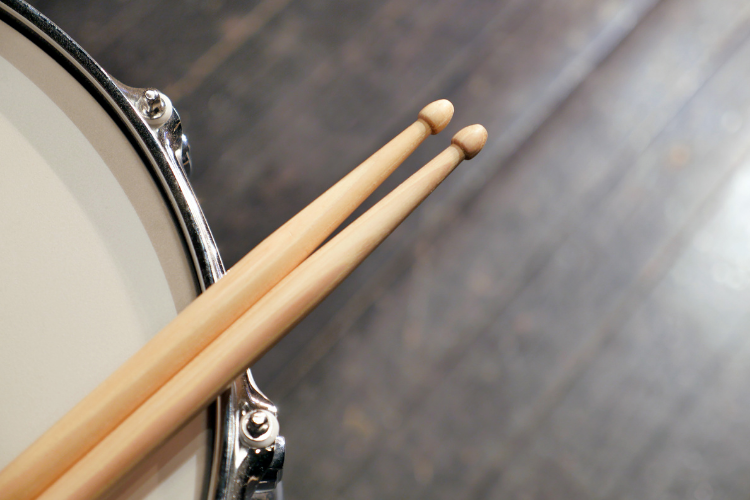
The butt end of the stick acts as a counterbalance to the pointed end. When utilized in reverse to the tip, the butt end can provide increased volume and power. The rubber-dipped butt end of the Zildjian DIP sticks has a sticky surface for increased comfort and a solid grip.
The shoulder is the area directly behind the tip and is widely utilized for cymbal crashes and swells and alternating with the hi-hat tips for a wide range of staccato sounds. The shoulder style is known as its taper, and it affects the sound and feel of the stick.
Short-tapered sticks have a firmer feel and are more resilient, whereas long, finely tapered sticks are more frail and flexible, with a more sensitive tone. The body is the main element of the stick, and it may be played on the rim for a wooden sidestick sound.
Different Woods
Today’s most preferred woods for drum sticks include hickory, maple, and oak. Maple, the thinnest wood used for drum sticks, has a low density and is best suited to the low-volume scenario and quick, light playing. Hickory is the most used wood in drum stick production because it is denser, heavier, and stiffer than maple.
Hickory is also good at absorbing stress, decreasing hand and wrist strain, giving it the wood of choice for baseball bats. Oak is a thick, long-lasting timber that is heavier than hickory. Drummers who prefer exotic woods, such as rosewood or Bubinga, will seek sticks made of these woods.
Synthetics
Polyurethane and aluminum are two common materials used to make synthetic sticks. They are incredibly stable, and some, such as the Ahead aluminum drum sticks, have removable tips, which wooden sticks do not have.
Different Types of Tips

Stick tips are available in four basic forms, each with tonal properties and either wood or nylon.
Round tips produce a concentrated sound that is particularly effective on cymbals, ranging from the tight ping sound of small round tips to the wider, richer tones of bigger round tips.
For a wider, more diffuse tone, barrel tips have a bigger contact area.
Sticks with pointed or triangular tips give a concentrated medium tone.
Depending on how they are handled, teardrop or olive-shaped tips generate various sounds ranging from closely concentrated to diffuse.
Many drummers favor nylon tips because of their enhanced durability and dazzling, distinct sound, although some like wood tips’ softer, warmer sound.
Selecting the Right Sticks for You
Most drummers use a range of sticks for various types of playing. On average, thicker sticks are the logical choice for rock and R&B styles that require a powerful backbeat.
For jazz, folk, and acoustic forms, lighter sticks are preferred. Experimentation is crucial here, so try out a variety of sticks to find suitable ones for you. Many drummers prefer to practice with heavier sticks than they use for performances to build strength and stamina.
5A sticks with nylon tips are a wonderful choice for playing a range of genres and general use. 2B sticks are excellent for developing accuracy and technique in beginner drummers. Again, experiment to discover a suitable match for your style, and remember the motto of all great drummers: practice, practice, practice.
Each of these sticks I picked are sticks with a quality grip for playing, have a consistent sound so you can rely on each pair to play the same. Lastly, durability is incredibly important. You are constantly putting wear on your sticks, so a pair you won’t have to worry about snapping in the middle of your set is essential for every drummer regardless of style.
Best Drumsticks for Beginners and Pro Drummers
Vic Firth American Classic 5A
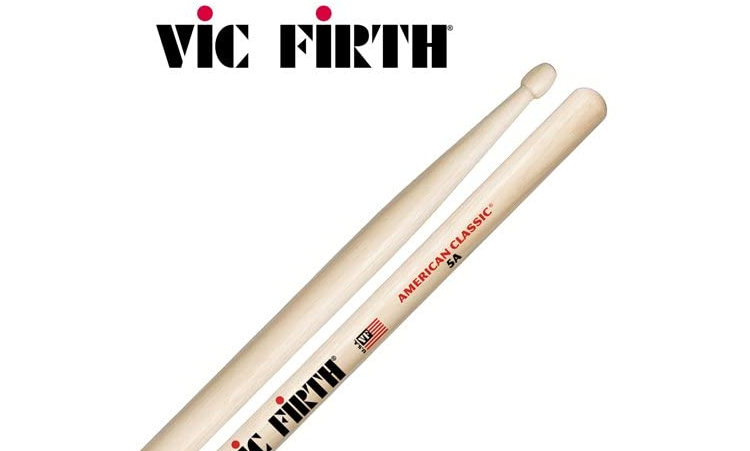
- Stick material: Hickory
- Length: 16″
- Diameter: .565″
- Tip: Teardrop
- Best for playing Rock music
Drummers that play rock music must have a lot of strength and energy. To do this, any rock drummer should start with a 5A type stick, and there is no better example than Vic Firth’s American Classic 5A.
These sticks are often considered the ideal stick for rock, with appropriate length, a medium taper for extra strength, and a significant diameter for the average drummer’s hands.
The teardrop tip provides a powerful blend of attack and warmth, assisting everyone from milder players to heavy hitters in coaxing grandiose tones from their drums. Each stick is covered with a silky lacquer, which promotes comfort and assists grip when your hands sweat following prolonged hours of use.
Pros
- Favorite among Rock Drummers
- Vic Frith is a quality brand
- Unmatched durability
Cons
- You may want a bulkier stick
Promark Hickory Junior Wood Tip

for younger drummers and kids
- Stick material: Hickory
- Length: 13″
- Diameter: .531″
- Tip: Oval
The best stick As younger players start playing the drums, they must utilize a drumstick that fits comfortably and easily in their tiny hands. Full-size sticks might be tough to hold because they are overly long and hefty.
This can affect technique and, in the worst-case scenario, turn off prospective young drummers before they’ve had a chance to build essential abilities and begin loving the drums.
Promark’s Hickory Junior Wood Tip sticks are the greatest drumsticks for youngsters, measuring a mere 13″. They’re shorter than normal models, creating a more comfortable, natural feel, while a medium taper promotes consistent balance and rebound, allowing important techniques to be learned quickly.
The oval tip is great for producing a well-rounded, warm tone from the drums, regardless of style.
Pros
- Less length for young players
- Made from very durable hickory
- Oval tip for versatile use
- Ideal rebound and balance
Cons
- I would not recommend older players or players with larger hands.
Vic Firth Nova 5A

- Stick material: Hickory
- Length: 16″
- Diameter: .565”
- Tip: Teardrop
- Great for drummers on a budget
Drumsticks are one of the less expensive purchases for drummers, but if you play frequently and find yourself breaking a lot, the expense of replacements quickly adds up. Vic Firth’s Nova Series sticks are composed of B-grade hickory, which helps to keep the price down, but they’re just as playable as premium sticks.
Like all Vic Firths, Novas are weight and pitch-matched before they leave the factory, ensuring that each pair feels balanced in your hands. At a fraction of the cost, it’s worth having a couple of pairs in your stick bag as backups in case you run out of your preferred sticks. Vic Firth also offers 5B and 7A Novas in a variety of colors in addition to the 5A model.
Pros
- Much cheaper than other sticks
- Pitch and weight-matched
- Versatile teardrop tip
Cons
- It Will does not last as long as pricier sticks.
Vater Manhattan 7A
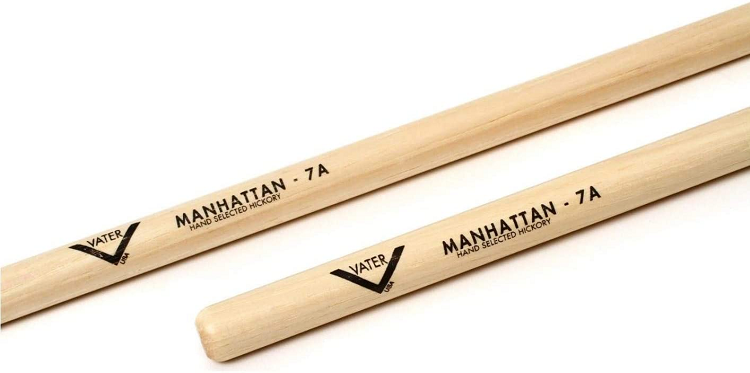
- Stick material: Hickory
- Length: 16″
- Diameter: .540”
- Tip: Rounds
- Best sticks for beginners
If you’re a fully grown adult learning to play the drums for the first time, it’s critical that you start with a drumstick that provides the optimum feel, length, balance, and power. Then, as you progress, you may begin to experiment with alternative models that fit your specific playing demands.
The 7A size isn’t that large in the hands and is sleek enough to allow you to master key skills quickly. Vater’s Manhattan 7A is the epitome of this. It’s a high-quality stick that’s easy to use, with a tiny round tip for crisp and defined cymbal playing.
It’s such a versatile drumstick that you might never need to play with anything else. Vater sells this stick with either wood or nylon tips.
Pros
- Manageable dimensions
- Vater is high quality.
- Smaller round tip for articulation
Cons
- Not recommended for metalheads
Meinl Stick and Brush Hybrid 5A Stick

- Stick material: Hickory
- Length: 16.25″
- Diameter: .565”
- Tip: Hybrid
- Best drumsticks for the modern player
Modern drummers no longer stick to a single style, instead of incorporating everything from rock and pop to hip-hop and dance music, often within the same track.
As a result, they require a stick that can withstand the rigors of varied and vigorous drumming. Meinl’s Stick and Brush is a relatively new brand on the market, but the firm is well-known for its innovative approach to percussion items.
Meinl’s new Hybrid model sticks, which include 5A, 5B, and 7A models, have an intriguing Hybrid tip that begins as an acorn shape before being trimmed down to a barrel, enabling dark and smooth cymbal articulation, while the extended length and taper make these sticks ideal for fast fills and intricate grooves.
Pros
- Created for modern drummers
- Unique hybrid tip design
- Longer stick for enhanced reach
Cons
- Meinl is a newer drumstick brand
Promark Shira Kashi Oak 7A Wood Tip

- Stick material: Japanese oak
- Length: 15 ⅜”
- Diameter: .512”
- Tip: Oval
- Best for playing jazz
The most popular drumstick material is hickory, although there are many more options to pick. Shira Kashi Oak is thick and hefty, both excellent qualities for cymbal articulation, making it an excellent choice for jazz drummers.
Japanese oak is also recognized for its durability, so if maintained properly, these Promark sticks could last longer than hickory equivalents – we’re huge supporters of this, given the greater price.
The Shira Kashi Oak model‘s shorter length and smaller diameter allow the musician to inject more delicacy and dynamism into their drumming while maintaining a sense of balance and control in the hands. The oval tip on the business end extracts a darker, warmer tone from your drums.
Pros
- Shorter length and lightweight, ideal for jazz
- Japanese oak is dense and long-lasting.
- Oval tip helps produce darker tones.
- Great for cymbal articulation
Cons
- More expensive than hickory
Ahead Classic 2B
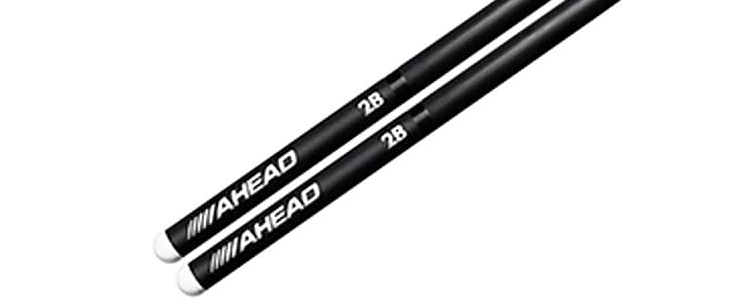
- Stick material: Aluminium/nylon
- Length: 16”
- Diameter: .595”
- Tip: Oval
The best sticks for hard heaving hitting metal drummers
When you’re a heavy metal drummer who is continually breaking drumsticks, you might want to look into alternative materials to make sure nothing gets in the way of you and your blast beats.
Ahead drumsticks are regarded for being incredibly robust, featuring an anodized aerospace-grade aluminum core and tough polyurethane coverings, and ‘unbreakable’ nylon tips. A vibration reduction device is built into each stick to assist in alleviating the stress of heavy play.
Ahead’s 2B model has a strong feeling in the hands and is ideally designed to encourage forceful playing while remaining light enough to pull off rapid rhythms. Ahead says that its sticks last up to ten times longer than wooden drumsticks, which helps to offset the higher price tags
Pros
- Most durable sticks out there
- Ideal for metal drummers
- Replaceable sleeves and tips
- Vibration control
Cons
- More durable but a higher price
Zildjian Artist Series Sticks

- Price: Various
- Stick material: Hickory
- Length: Various
- Diameter: Various
- Tip: Various
The top choice for artist series stick
Zildjian’s extensive artist list includes everyone from Dave Grohl and Ringo Starr to Dennis Chambers, Travis Barker, and Josh Dun. Many of their performers also use Zildjian-branded sticks, which speaks something about the quality and variety of drumsticks they provide.
If you go deep into the Zildjian artist drumstick lineup, you’ll find a variety of gauges, tip kinds, and colors to meet your specific likes and demands. It’s worth testing out your favorite drummer’s stick first, but who knows, maybe you’ll find the right stick wearing the name of a drummer you hadn’t considered before? It’s worth a try.
Pros
- Large range of artist models
- Designed with your favorite player
- Many options to suit your style
Cons
- Many do not have the model for you.
Regal Tip Nylon Series

- Price: Various
- Stick material: Hickory
- Length: Various
- Diameter: Various
- Tip: Nylon, various shapes
- Best nylon drumsticks on the market
Nylon-tipped drumsticks provide a highly distinct, defined sound from your drums and cymbals, which is an effect that many drummers seek; not to mention, your sticks should last longer due to the sturdy nylon tip.
Regal Tip designer Joe Calato was the brains behind the original nylon tip back in 1958, and their Nylon Series provides several stick types encompassing many genres, all wearing the iconic tip. The drumstick company also assures that its nylon tips will not budge, even under the most intense playing conditions.
Pros
- Nylon adds definition to your stick
- Improves life of the stick
- Range of models available
Cons
- You may not like the extra attack
Promark Classic 5B Firegrain
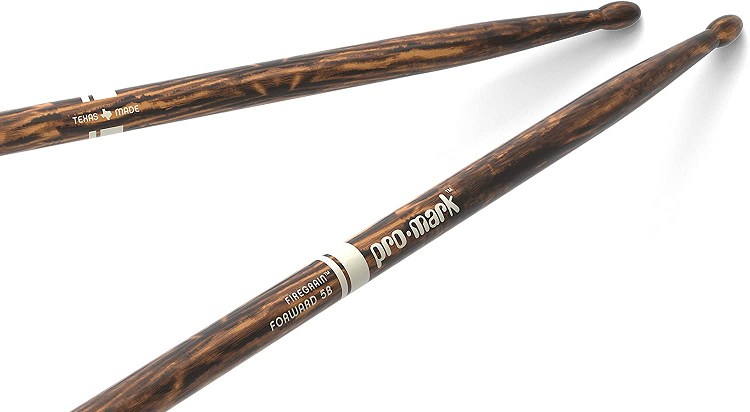
- Stick material: Hickory
- Length: 16″
- Diameter: .590″
- Tip: Oval
- Best sticks for long term durability
Every drumstick maker on the globe has tackled the issue of stick durability with various degrees of success. If breaking sticks are a common occurrence behind your setup, but you don’t want to go synthetic, Promark’s Firegrain sticks may be the most persuasive alternative yet.
These one-of-a-kind drumsticks have been heat-tempered, which hardens the hickory and increases strength and longevity without affecting the feel and tone of the stick. It’s a viable option that more than justifies the somewhat higher-than-average price tag.
Pros
- Heat-treated for durability
- Mainstream sizes available
- Look great
Cons
- Less flex than regular drumsticks
FAQ
Answer: The weight and length of your drumsticks will have the most influence on how they feel and sound. Thicker, heavier sticks provide more volume and longevity, making them the best choice when a lot of projection is required. Thinner, lighter sticks are simpler to handle and allow more control in settings requiring finesse, such as a small ensemble.
Answer: Stick sizes are often denoted by a letter and a number, such as 2B or 5A. The number denotes the length of the stick. The wider the diameter, the smaller the number. As a result, a number 7 drumstick is rather thin. A number 5 is significantly thicker, while a number 2 is quite thick. Remember that higher numbers are intended for more subtle play.
Traditionally, the letter in a drumstick model number signified the type of music the drumstick was designed to play.
A – for “orchestra” model
B – for “band” model, designed for concert band
S – for “street” model, designed for marching bands
Answer: Most manufacturers provide the traditional models: 2B, 5A, 5B, and 7A, however, sticks in 1, 3, 8, and 9 are occasionally available. Certain brands have begun to create their own versions of these sticks, with distinct catalog codes that may or may not correspond to the size or form of the stick. However, most will include a chart comparing their drumsticks to well-known models.
5A – Universal Standard, 16” long
3A – Thicker version of 5A, generally 16”-17”
5B – Thicker than 3A, 16”
7A – Thin stick, 15”-15.75”, perfect for jazz
8D – Longer version of 7A, 16”-16.5”
1A – The longest stick available, 16.25’-17.25”
2B – The thickest stick available, 16”, perfect for metal
Answer: Using the right size drumstick is critical for learning basic techniques for a new drummer. However, not all newcomers should begin with the same stick. A young pupil with small hands should begin with a smaller stick than a starting adult.
The 7A is often appropriate for youngsters, whereas the 5A is appropriate for teens and adults. Some companies, like Vic Firth and Promark, also offer a stick type designed exclusively for a young drummer’s little hands, such as the Vic Firth Nova 5A and the Promark Hickory Junior Wood Tip.
Answer: Every drummer can have their own set of drumstick preferences. The only accurate answer is to find the sticks that feel the most comfortable to you and provide the most control. This may necessitate some trial and error, but locating drumsticks that fit your playing style will help you get the greatest sound on the set.
In general, 5A’s are a fantastic place to start for beginners since they are well suited to a variety of genres ranging from rock to jazz. Intermediate drummers may want a heavier stick, such as the 5B, which is suitable for Rock, Funk, and Metal.
Advanced drummers are typically pickier about the sticks they use, however many inclines to either very heavy sticks, such as the 2B, or very thin sticks, such as the 7A or the 8D, based on their genre.
Conclusion
Many stick companies use famous drummers to promote their products, often in the guise of signature drumsticks – that is, sticks designed to the exact specifications of the drummer in question, and usually with their name or band logo adorned on the stick.
Many regular drummers swear by the signature model of their favorite drummer. But are signature sticks always the way to go? Yes and no…
You could discover that your favorite drummer’s trademark stick is a wonderful fit for you and your playing style and that it checks all the taper, thickness, length, and tip boxes.
Your favorite drummer, on the other hand, may choose to play a super thick, extra-long model that is simply too ungainly for you. So, if you realize that your hero’s stick isn’t for you, you must be honest with yourself.
The stick I would recommend would be the Meinl Stick and Brush Hybrid 5A stick. They are such versatile sticks that are essential for the modern player. The standard 5A is a great starting point for any player.
The Meinl can handle so many genres and with a lengthened stick you can have optimal drumming which most sticks lack. While Meinl is new to the stick game, they aren’t new to a forward-thinking approach that has given their brand such a promising reputation.

